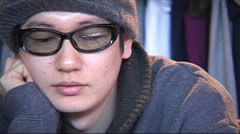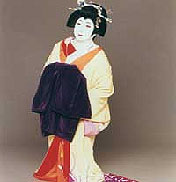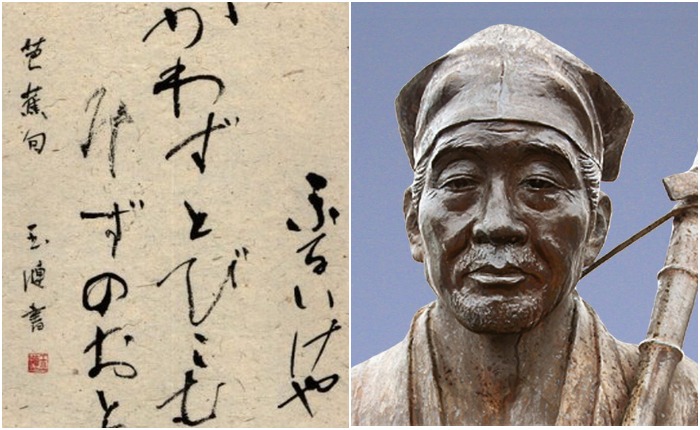BEAUTY OF BUDDHIAN AND SINTOIST SCULPTURE ATTRACTS THE SHOWER OF A EUROPEAN
 Having bought an amazing enameled vase decorated with a figure of some deity as a Christmas present for my daughter, I wanted to find out who is depicted in this vase. And I headed to the house of Monasmit Byron, located in the Tokyo area of Sinanomati.
Having bought an amazing enameled vase decorated with a figure of some deity as a Christmas present for my daughter, I wanted to find out who is depicted in this vase. And I headed to the house of Monasmit Byron, located in the Tokyo area of Sinanomati.
Byron put on tiny Taisho-era silver-framed glasses (1912-1926) and delved into the reference book.
“This is the deity of Benzai-ten, better known as Benten-sama, the prototype of which was the Hindu goddess Saraswati. Benzai-ten is the only female deity among the Shifufujin – the seven Shinto gods of fortune. The goddess of water and music, she is usually portrayed playing the lute” biwa ” as in this vase, “he said.
I knew that I had come to one of the most competent experts.
When I came to Byron again, but as a journalist, to talk with him in more detail, he photographed a black lacquered zushi – a vertical double-leaf casket where Buddhist statues are usually placed, preparing to sell it at the eBay online auction. Since good photography means a bargain in a growing virtual market, Byron painstakingly took pictures of an antique object from various angles. In addition, his commentary on the auctioned item was written flawlessly beautifully.
Although Byron does not call himself a professional dealer for the sale of Japanese antiques, he is moving very quickly in this direction.
“I started collecting Japanese Buddhist sculpture six years ago when I moved to this house. One of my friends showed particular interest in the statuette Yakushi Nyorai (The Buddha of Medicine), and I agreed to sell this figure to her. So my business began.”
As the youngest of six children in a family of school teachers, Byron grew up in a small rural town in eastern Colorado. Without passing the entrance exam in chemistry at Harvard University, Byron broke up with the dream of becoming a doctor.
“I thought that the course of Chinese history looks very attractive. As a result, it led me to study the history of Japan,” he says.
Having received a bachelor’s degree in history, Byron arrived in Tokyo in the fall of 1987. “I just wanted to see places that I read a lot about,” he says.
For about a year, the Baron worked in the editorial office of one of the newspapers, and then went to Paris, where he studied the technique of playing the organ and harpsichord.
“In 1996, I returned to Tokyo, worked as a freelance correspondent in several newspapers, and at the same time attended a master’s program in the Faculty of Oriental Studies at Jöti University. Most of my freelance work was in the summer, the rest of the time I devoted to the fundamental study of Japanese Buddhism and fine art.”
Indeed, Byron’s business is progressing successfully thanks to his knowledge of the history of Buddhism, the talent of a researcher, as well as the skill of a journalist and photographer.
“I started to visit all the flea markets and bazaars selling antiques. I was especially attracted to wooden sculpture. Then one day a young guy offered me a pair of wooden sisi lions – a great job done in Okinawa. I bought them right away,” Byron says.
By studying Buddhism, Byron tries to avoid the influence of traditional religious superstitions. In particular, he is not afraid that he will provide shelter for his house to some evil spirit.
“I am far from the anthropology of religion and am guided exclusively by an aesthetic approach. In addition, I am interested in the story of the creation of a complex pantheon of deities of Japanese Buddhism, rooted in Indian religions, then subjected to Chinese and Korean influence and closely intertwined with Shinto native to Japan.”
Dozens of stone figures lined up along a moss-covered path to his traditional home.
“I grew up with a love for stone. Demand abroad for a Buddhist stone sculpture is very limited; in addition, transportation is very expensive. But I cannot help but buy a stone sculpture, because I get it from my best supplier – a young dealer from Shizuoka, which, oddly enough, receives its goods directly from road construction companies. ”
The interior of the Byron house includes many exhibits flickering with gold and varnish. The owner proudly shows the old statues with the remains of ancient paint on the surface and carefully hides them in the dark openings of the “zushi” caskets.
To illuminate his exhibits, Byron uses a small portable halogen lamp, and sometimes even a simple lighter. Since strong light acts destructively on old statues, Byron keeps rooms in the dark. Fortunately, he and his four cats learned to see in the dark and distinguish all the necessary objects.
This year Byron plans to seriously expand his business, for which he needs to open his own website. Over the past six months, taking an active part in eBay online auctions, Byron has created an international clientele network.
“My delightful Dutch couple became my best customers in Europe. I offer them products at very reasonable prices, which means a lot to the success of my business abroad.”




